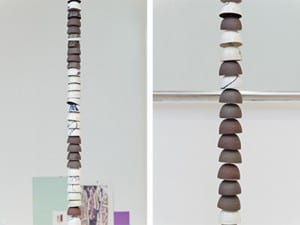Patricia Mato-Mora is a ceramic artist and writer based in London. Her work Untitled (2014) was selected for this year’s Aesthetica Art Prize longlist and is featured in 2015’s guide to new, pioneering artists, Future Now. Her work involves creating ceramic pieces with a strong narrative function that engages with space, bridging the gap between materiality and spatiality that architecture mediates through drawings. We speak to Mato-Mora about her work that spans sculpture, architecture and drawing.
A: Your latest project, Mass Produced Handmade, featured in the Up and Coming section of this year’s Ceramic Art London. Can you tell us a little about the project?
PM: The genesis of this piece can be traced back to my research into the Victoria and Albert Museum Ceramic collection. In it, I found a series of sea sculptures formed after the junk that transported them caught fire and sunk off the coast of Vietnam.
No craftsman could have possibly designed or conceived these ceramic freaks – not in a state of contained sobriety anyway. The sea sculptures and the story behind them beguiled me. Mass-Produced Handmade takes this story into the gallery space – a pile of ninety tea bowls grows from the floor and disappears into the ceiling.
A: Your 2014 piece Untitled was longlisted for the Aesthetica Art Prize. Can you explain how the creative processes behind Untitled and Mass Produced Handmade pieces compared?
PM: I am very interested in how spaces can act as vessels for collective imagination; how different individuals can meet in a space and imagine stories that have or could have taken place there, as well as project their own narratives into the space.
Both Untitled and Mass-Produce Handmade are explorations in this direction. I don’t think either piece is conclusive – rather, these artworks interpret the phenomenon open-endedly: space and story collide in the pieces.
Untitled aims at telling the story of its own formation and destruction – as the piece was made and dismantled in the gallery, building and demolition became part of this muscular, yet in some sense frail, ceramic sculpture.
A: How does your architectural background inform your aesthetic? What other elements inform the manner in which your art presents itself?
PM: Space is an integral part of my aesthetic, or rather, what concerns me as an artist – although I am currently practicing as an artist, architecture and space are what I am truly fascinated about. I think about art as the way in which human beings organise material matter in the space that surrounds them – my dissertation at the Royal College of Art is researching this topic and contextualising it in contemporary art practice. Clay is important for me and my aesthetic given its immediacy, and the directness with which a single human without complicated tools or technology can alter its qualities.
A: You teach architecture and design at university, and, additionally, you run Drawing the City, a drawing school you founded yourself. What inspired you to teach, and what’s the most important lesson in your curriculum?
PM: Drawing the City was founded by myself and Michael Kloihofer in 2014 as a way of promoting a new kind of city exploration – the architectural fabric of the city is experienced and fully acknowledged, understood and documented through drawing. Drawing enables architects and designers to communicate ideas in a fluid manner. In spite of this, drawing has recently taken the back seat in formal architecture and design training – this is one of the reasons Drawing the City was necessary, and also why it has been a great success since its inception.
Drawing the City is organised around a series of urban explorations, as well as studio sessions, group reviews and exhibition visits. The beauty of shadows created by buildings – that is what I would point out to architects and designers as a good lesson we wouldn’t have learnt, had we not been drawing!
A: Finally, tells us something about your upcoming projects and future plans.
PM: Following Ceramic Art London, I have received commissions to create new incarnations of this piece, Mass-Produced Handmade. I am very excited about continuing to develop this project further.
This summer I have some collaborations lined up, for ceramics projects on a large scale that explore topics in line with Mass-Produced Handmade, both technically and conceptually.
Thinking five years ahead; there are some artist residencies I would like to take part in. I would also like to continue to think across the disciplines of architecture, ceramics and writing; both professionally and academically; with my architecture and design students.
To see more work by Patricia Mato-Mora, visit www.pmatomora.net
For more information on the Aesthetica Art Prize, which is currently open for entries, visit www.aestheticamagazine.com/artprize
Credits
1. Patricia Mato-Mora, Untitled (2014)
2. Patricia Mato-Mora, Mass Produced Handmade.







